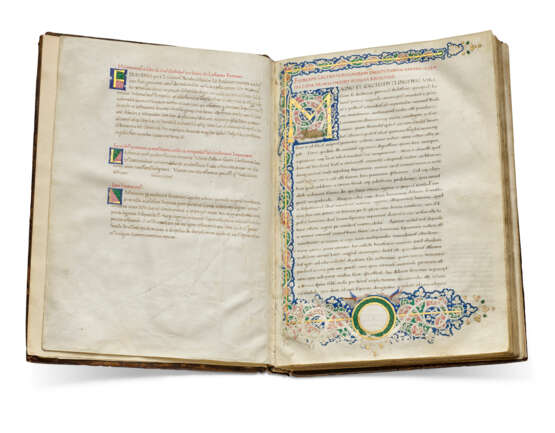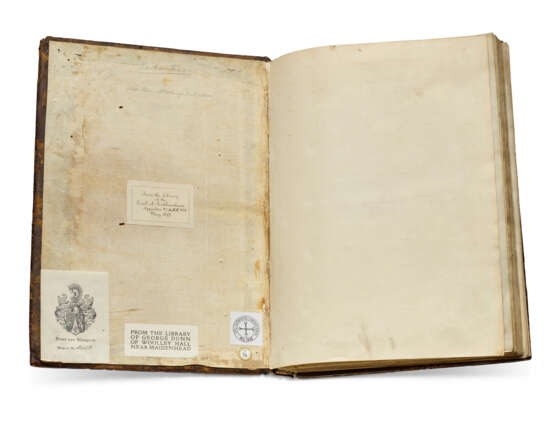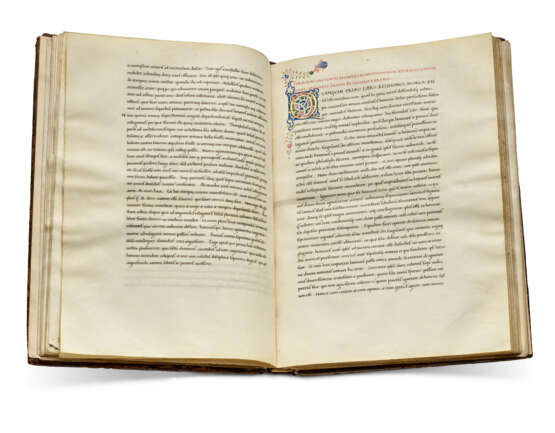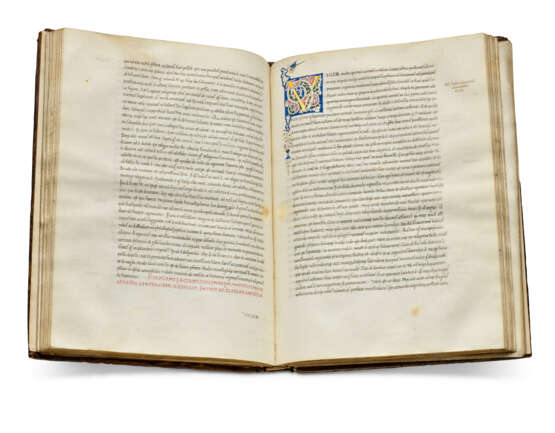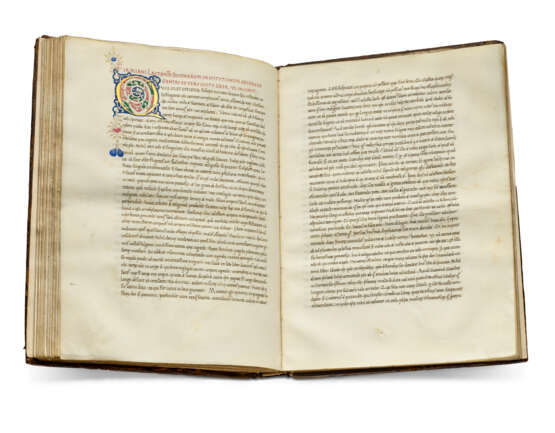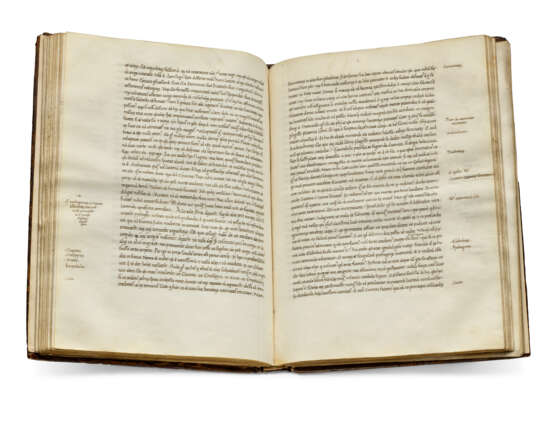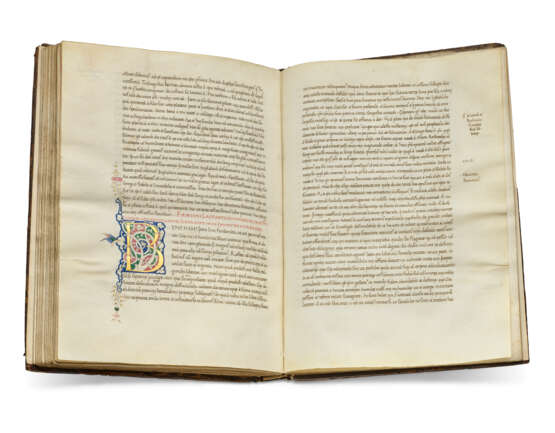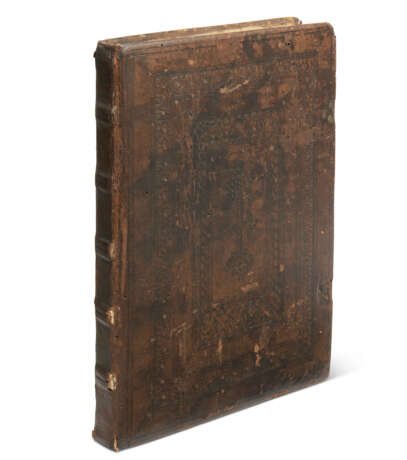ID 1214887
Los 40 | The Tanaglia Lactantius
Schätzwert
£ 200 000 – 300 000
Lactantius (c.250-c.325), Divinae Institutiones, in Latin, illuminated manuscript on vellum [Florence, c.1420-30 and c.1450s]
A superb illuminated humanist manuscript of a central humanist text with impeccable humanist provenance: a copy of Lactantius' Divinae Institutiones written and owned by one of the most important figures in Renaissance humanism, Guglielmino Tanaglia, filled with his annotations. In the mid-15th century it was owned by the famed humanist bookseller Vespasiano da Bisticci, who likely had it rebound and illuminated by Filippo di Matteo Torelli. Subsequently in the celebrated collections of the Earl of Ashburnham, Henry Yates Thompson, and George Dunn.
323 x 230mm. i (paper) + 125 + i (paper) leaves, collation: 111(of 10, i an inserted singleton), 2-710, 89 (of 10, lacking vi, after f.120), 9-1210, 135(of 8, vi-viii cancelled blanks), the first three gatherings of 32 lines written by an anonymous scribe whose handwriting is extremely similar to Poggio, ruled space: 228 x 142mm; the remaining gatherings of 33 lines written by Guglielmino Tanaglia, catchwords survive, several sentences in Greek, headings in red capitals, final page with 3 initials in blue, 3 small illuminated initials on the first page, 6 large white-vine initials including three-quarter illuminated border on title leaf, borders inhabited by a sleeping leopard, birds and butterflies, annotations by Guglielmino Tanaglia throughout (lacking one leaf with white-vine initial opening Book V, a few marginal stains but in exceptional condition with wide, clean margins). Contemporary Florentine blind-stamped binding with remnants of gilding or paint, edges gilt and gauffered (lacking clasps and catches, a little scuffed). Fitted box.
Provenance:
(1) It was previously suggested that the first copyist and original owner of the manuscript, responsible for ff.1-29v, may have been Niccolò Niccoli (1364-1437), Renaissance humanist and collator of manuscripts, and one of the chief figures in the humanist entourage of Cosimo de' Medici. De la Mare had previously hypothesised it could be Giovanni Aretino (Giovanni di Cenni) in 'Humanistic Script: The First Ten Years', Das Verhältnis der Humanisten zum Buch, 1977, p.105. The hand is, though, much more similar to that of Poggio Bracciolini, the famous early Renaissance humanist noted for rediscovering and recovering many classical Latin manuscripts (among which Lucretius' De Rerum Natura; Vitruvius' De Architectura; and several lost orations by Cicero). Characteristic is the '&' also found in Florence, Biblioteca Medicea Laurenziana, MSS Plutei 48.27, 67.11 and 83.4. De la Mare discusses this anonymous copyist in 'Humanistic Script', 1977, pp.94-95 and again in 'Cosimo and his Books', Cosimo "il Vecchio" de' Medici, 1389-1464, 1992, pp.141 and 151 (respectively nos 8, 60 and 63 in her list of manuscripts owned by Cosimo de' Medici). This scribe is also mentioned by Teresa de Robertis in 'I primi anni della scrittura umanistica. Materiali per un aggiornamento', Palaeography, Manuscript Illumination and Humanism in Renaissance Italy: Studies in Memory of A. C. de la Mare, 2016, note 27.
(2) Guglielmino Tanaglia (1391-1460), protohumanist scholar and statesman, friend of Poggio Bracciolini. De la Mare identified his hand in ff.30-125. The change in hand is evidenced by the different '&', the diphthong 'ae' and the 'g', and the greater irregularity in the size of the letters. The present copy of Lactantius is by far the most substantial extant manuscript by Tanaglia. Examples of his writing and annotations (which all end with a characteristic full-stop) can be found in a Eusebius at St Gall, Kantonsbibliothek, Vadianische Sammlung, VadSlg Ms. 298; in a manuscript in Florence, Biblioteca Medicea Laurenziana, MSS Plutei 65.35 (later owned by Cosimo de' Medici); and Rome, Biblioteca Apostolica Vaticana, Vat. lat. 10665. On his importance in the development of humanist scholarship see A.C. de la Mare, 'Humanistic Script, the First Ten Years', pp.105-6. There are accounts of Tanaglia as a notable Florentine judge in L. Martines, The Social World of the Florentine Humanists, 1390-1460, 1963, pp.331-2. At some point, it seems likely that the manuscript entered the bookshop of the great humanist book merchant and librarian Vespasiano da Bisticci (1421-1498) who may well have been responsible for having it rebound in its current Florentine binding and illuminated by Filippo di Matteo Torelli.
(3) Bertram Ashburnham, 4th Earl of Ashburnham (1797-1878), British peer and one of the great manuscript collectors of the 19th century: published in Catalogue of the Manuscripts at Ashburnham Place, Appendix, c.1853, cat. no LXXVI. The 'Appendix' collection was sold en bloc to Henry Yates Thompson in 1897.
(4) Henry Yates Thompson (1839-1928), the greatest manuscript collector of his generation. Thompson’s goal was to possess one hundred of the finest manuscripts that he could acquire and once these were established, he refined the collection by discarding items to make way for new acquisitions. Much of the collection was dispersed before his death in 1928, and the remaining items were bequeathed to the British Museum by his widow.
(5) George Dunn (1865-1912), of Woolley Hall near Maidenhead: his book label on inside upper cover. His sale at Sotheby's, 14 February 1913, lot 552.
(6) Victor von Klemperer (1876-1942), of Dresden: his bookplate and no 2603. By descent to his heirs and sold at:
(7) Sotheby's, 18 June 1991, lot 80, for £86,000 to:
(8) The Schøyen Collection, MS 1369.
Contents:
Guglielmino Tanaglia (1391-1460), notes on the life of Lactantius f.1v; Lucius Caelius Lactantius (c.250-c.325), Divinae Institutiones, Book I opening 'Firmiani Lactantii Divinarum Institutionum Adversus Gentes [...] Magno et excellenti ingenio viri', ff.2-24v; Book II ff.25-41v; Book III ff.42-59; Book IV ff.59v-76; Book V (lacking opening) ff.77-91; Book VI ff.91v-109v; Book VII ff.109v-125v, ending 'a domino consequamur', followed by three short quotations from St Augustine, ending '[...] esse ventura'.
The Divinae Institutiones is a systematic work that endeavours to ‘point out the futility of pagan beliefs and to establish the reasonableness and truth of Christianity’ (P. Healy, 'Lucius Caecilius Firmianus Lactantius', The Catholic Encyclopedia, 1910). Written between 303 and 311 and dedicated to Constantine the Great, it is the most important of Lactantius' works, and represented the first attempt at a systematic exposition of Christian theology in Latin, as well as a repudiation of what Lactantius perceived as the superstitions of pagan cults. Although his grasp of the scriptures was not always firm (and of astronomy: Lactantius's mockery of the idea of a round earth was criticized by Copernicus in the preface to his book De revolutionibus orbium coelestium), Lactantius showed a keen awareness of classical authors, but also Jewish, Egyptian and Iranian apocalyptic material. He was referred to as the 'Christian Cicero' by Renaissance humanists and the text, regarded as a model of classical style, was central among early humanist circles. It was, for this reason, one of the first books to be printed in Italy (as well as the first Italian imprint to be dated).
Of paramount importance here are the extensive marginal notes by Guglielmino Tanaglia. We see, for example, how the Divinae Institutiones was seen as a primary text for the history of Neoplatonism: on ff.45, 115, 116v, etc., Tanaglia draws attention to discussions on the immortality of the soul.
Illumination:
The six very fine white-vine illuminated initials are the work of one of the outstanding illuminators of Renaissance Florence, Filippo di Matteo Torelli (fl.1440-1468). He is responsible for a splendid Gospel Book at the Laurenziana (Florence, Biblioteca Medicea Laurenziana, Edili 115), and collaborated with Zanobi Strozzi on a series of choirbooks for the Cathedral of Santa Maria del Fiore and the Basilica of San Marco in Florence (this work had previously been attributed to Fra Benedetto, brother of Fra Angelico).
Christie's is grateful to Laura Nuvoloni for the identification of the scribes and her help in the preparation of this catalogue note.
| Herkunftsort: | Italien, Europa |
|---|---|
| Kategorie des Auktionshauses: | Handschriften des Mittelalters und der Renaissance, Bücher und Handschriften |
| Herkunftsort: | Italien, Europa |
|---|---|
| Kategorie des Auktionshauses: | Handschriften des Mittelalters und der Renaissance, Bücher und Handschriften |
| Adresse der Versteigerung |
CHRISTIE'S 8 King Street, St. James's SW1Y 6QT London Vereinigtes Königreich | |
|---|---|---|
| Vorschau |
| |
| Telefon | +44 (0)20 7839 9060 | |
| Aufgeld | see on Website | |
| Nutzungsbedingungen | Nutzungsbedingungen |
